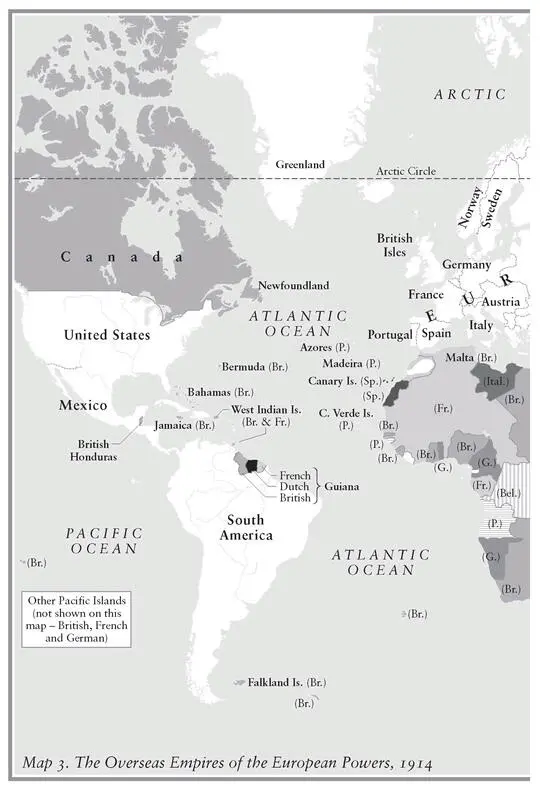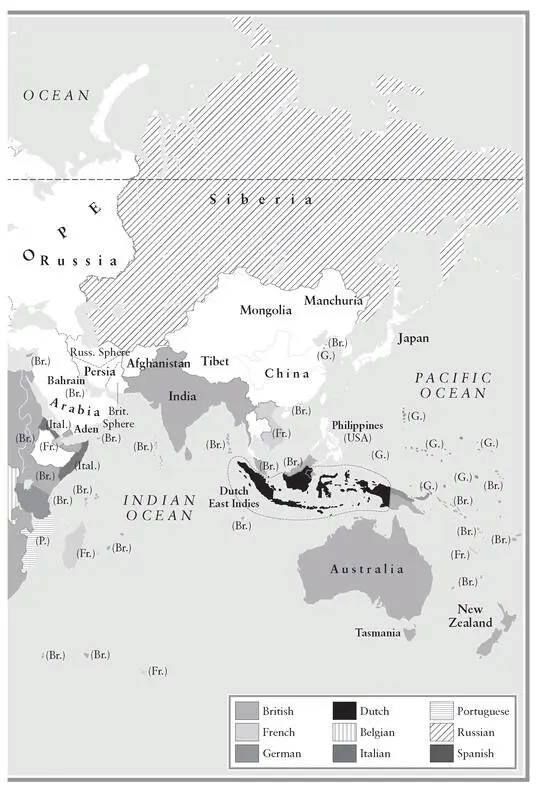The economic chasm that opened up between Europe and nearly everywhere else greatly enhanced its ability to dominate the world. [100] [100] Samuel P. Huntington, The Clash of Civilizations and the Remaking of World Order (New York: Simon and Schuster, 1996), pp. 48–53; Eric Hobsbawm, The Age of Empire 1875 - 1914 (London: Weidenfeld and Nicolson, 1987), Chapter 3.
The colonial era had started in the seventeenth century, but from the middle of the eighteenth century onwards, with the progressive acquisition of India, it rapidly expanded. In the name of Christianity, civilization and racial superiority, and possessed of armies and navies without peer, the European nations, led by Britain and France, subjugated large swathes of the world, culminating in the scramble for Africa in the decades immediately prior to 1914. [101] [101] Hobsbawm, The Age of Empire , pp. 57-9, 70–73.
Savage wars took place between whites and non-whites as Chinese, Indians and native peoples in North America, Australasia and southern Africa made their last stand against European assaults on their religions, rulers, land and resources. [102] [102] Bayly, The Birth of the Modern World , pp. 127-8.
Niall Ferguson writes:
Western hegemony was one of the great asymmetries of world history. Taken together, the metropoles of all the Western empires — the American, Belgian, British, Dutch, French, German, Italian, Portuguese, and Spanish — accounted for 7 % of the world’s land surface and just 18 % of its population. Their possessions, however, amounted to 37 % of global territory and 28 % of mankind. And if we regard the Russian empire as effectively another European empire extending into Asia, the total share of these Western empires rises to more than half the world’s area and population. [103] [103] Niall Ferguson, ‘ Empire Falls ’, October 2006, posted on www.vanityfair.com, pp. 1–2.
As the world’s leading power, Britain sought to shape the new global trading system according to its interests. Its national wealth depended on exporting its manufacturing products to as many markets as possible while importing food and raw materials at the lowest possible prices. Laissez-faire was not simply an abstract principle or a disinterested policy. It was the means by which Britain tried to take advantage of its overwhelming advantage in manufacturing and prevent others from seeking to erect tariffs to protect their nascent industries. The international free trade regime championed by Britain had a stifling effect on much of the rest of the world outside north-west Europe and North America. Industrial development in the colonial world was for the most part to prove desperately slow, or non-existent, as the European powers tried to prevent or forestall direct competition for their domestic producers. ‘Whatever the official rhetoric,’ writes Eric Hobsbawm, ‘the function of colonies and informal dependencies was to complement metropolitan economies and not to compete with them.’ [104] [104] Hobsbawm, The Age of Empire , p. 65.
The urban population — a key measure of industrialization — in the British and French empires in Asia and North Africa remained stuck at around 10 per cent of the total in 1900, which was barely different from the pre-colonial period, while standards of living may even have fallen over the course of the nineteenth century. [105] [105] Bayly, The Birth of the Modern World , p. 397.
India — by far Britain ’s most important colony (it was colonized by the East India Company from the mid eighteenth century, and formally annexed by Britain in 1857) [106] [106] Hobsbawm, The Age of Empire , pp. 68-9.
— had a per capita GDP of $550 in 1700, $533 in 1820, and $533 in 1870. In other words, it was lower in 1870 than it had been in 1700, or even 1600. It then rose to $673 in 1914 but fell back to $619 in 1950. Over a period of 250 years, most of it under some form of British rule, India’s per capita GDP increased by a mere 5.5 per cent. Compare that with India ’s fortunes after independence: by 1973 its per capita GDP had risen to $853 and by 2001 to $1,957. [107] [107] Maddison, The World Economy: Historical Statistics , p. 262; Maddison, The World Economy: A Millennial Perspective (Paris: OECD, 2006), p. 114.


Map 3. The Overseas Empires of the European Powers, 1914
Not only did Europe take off in a manner that eluded Asia after 1800, but it forcibly sought to prevent — by a combination of economic and military means — Asia from taking the same route. China was a classic case in point. The British fought the Chinese in the First Opium War of 1839-42 over the right to sell Indian-grown opium to the Chinese market, which proved a highly profitable trade both for Britain and its Indian colony. The increasingly widespread sale and use of opium following China ’s defeat predict-ably had a debilitating effect on the population, but in the eyes of the British the matter of ‘free trade’ was an altogether higher principle. China ’s ensuing inability to prevent the West from prising open the Chinese market hastened the decline of the Qing dynasty, which by the turn of the century was hopelessly enfeebled. When European and American expeditionary forces invaded China in 1900 to crush the Boxer Uprising, it was evident that little, other than imperial rivalry, stood in the way of China being partitioned in a similar manner to Africa. [108] [108] Jonathan D. Spence, The Search for Modern China , 2nd edn (New York: W. W. Norton, 1999), pp. 229-34.
Paradoxically, nothing serves to illustrate the overwhelming power of Europe more vividly than the rise of Japan. Stalked by the threat of Western invasion and fearful that it might meet the same fate as China, following the Meiji Restoration in 1868 Japan embarked on a carefully calculated process of rapid modernization. It sent teams of specialists to study the European systems of education, their armies and navies, railways, postal systems and much else. It rejected the idea that it was any longer a meaningful part of Asia and instead coveted acceptance as a Western power. It even emulated the Western model of colonialism, occupying Taiwan, Korea and part of China. The Meiji project of modernization was testament to the comprehensive character of European hegemony. Every other country lived in the shadow of Europe and was obliged, willingly or unwillingly, to adapt and adopt some of its characteristics, or face the threat of colonization. The rise of Europe changed the rules of the game for everyone else. The consequences were by no means exclusively negative: above all, Europe demonstrated what was possible through industrialization and thereby confronted the world with the ineluctable choice of modernization. Although imperial powers saw their colonies as the servant of their needs, and prohibited them from competing with their masters, some, nonetheless, acquired from their colonizers a few of the building blocks of their subsequent development. India obtained a widely shared language in English, Taiwan inherited the Japanese education system, and the Chinese in the treaty ports, especially Shanghai, learnt about Western commerce. [109] [109] Elvin, ‘The Historian as Haruspex’, p. 104.
But the balance of outcome was largely negative, as reflected in the economic evidence presented earlier as well as the profound popular hostility towards what was perceived by the great majority in the colonial world, then and now, as alien rule; in some cases, notably Africa, moreover, it was almost entirely negative. The one great exception was the white settler colonies of Australia, Canada and New Zealand: these were always treated entirely differently — for straightforward racial and ethnic reasons — and prospered greatly as a consequence. [110] [110] For a more positive view of the impact of colonialism, see Niall Ferguson, Empire: How Britain Made the Modern World (London: Penguin, 2004), pp. 365-81, especially pp. 368-71.
Читать дальше














